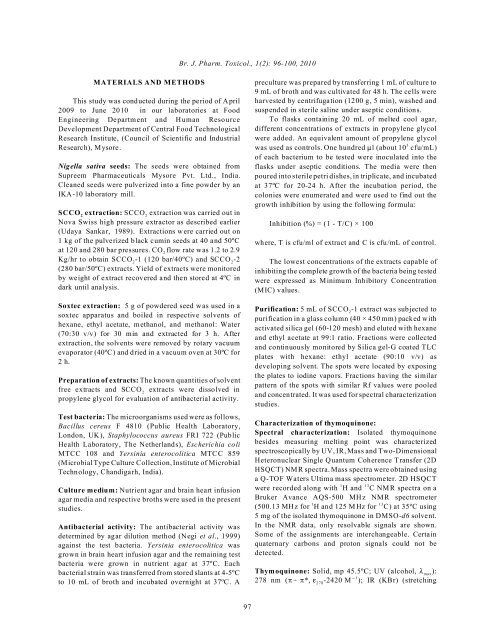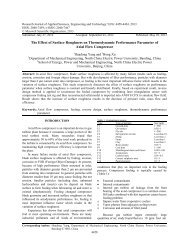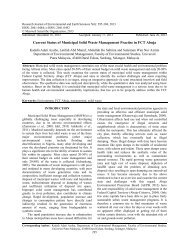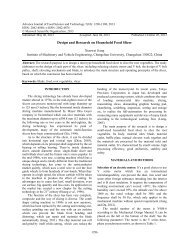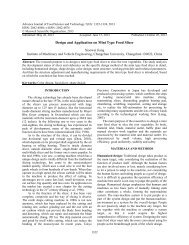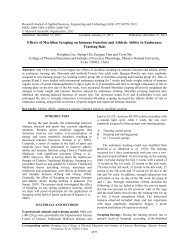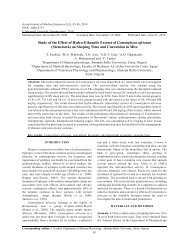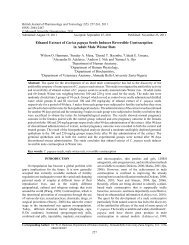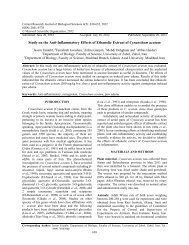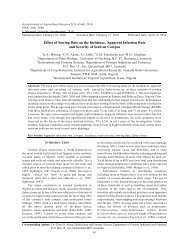Antibacterial Activity of Nigella sativa L. Seed ... - Maxwell Science
Antibacterial Activity of Nigella sativa L. Seed ... - Maxwell Science
Antibacterial Activity of Nigella sativa L. Seed ... - Maxwell Science
You also want an ePaper? Increase the reach of your titles
YUMPU automatically turns print PDFs into web optimized ePapers that Google loves.
MATERIALS AND METHODS<br />
This study was conducted during the period <strong>of</strong> April<br />
2009 to June 2010 in our laboratories at Food<br />
Engineering Department and Human Resource<br />
Development Department <strong>of</strong> Central Food Technological<br />
Research Institute, (Council <strong>of</strong> Scientific and Industrial<br />
Research), Mysore.<br />
<strong>Nigella</strong> <strong>sativa</strong> seeds: The seeds were obtained from<br />
Supreem Pharmaceuticals Mysore Pvt. Ltd., India.<br />
Cleaned seeds were pulverized into a fine powder by an<br />
IKA-10 laboratory mill.<br />
SCCO 2 extraction: SCCO 2 extraction was carried out in<br />
Nova Swiss high pressure extractor as described earlier<br />
(Udaya Sankar, 1989). Extractions were carried out on<br />
1 kg <strong>of</strong> the pulverized black cumin seeds at 40 and 50ºC<br />
at 120 and 280 bar pressures. CO 2 flow rate was 1.2 to 2.9<br />
Kg/hr to obtain SCCO 2-1 (120 bar/40ºC) and SCCO 2-2<br />
(280 bar/50ºC) extracts. Yield <strong>of</strong> extracts were monitored<br />
by weight <strong>of</strong> extract recovered and then stored at 4ºC in<br />
dark until analysis.<br />
Soxtec extraction: 5 g <strong>of</strong> powdered seed was used in a<br />
soxtec apparatus and boiled in respective solvents <strong>of</strong><br />
hexane, ethyl acetate, methanol, and methanol: Water<br />
(70:30 v/v) for 30 min and extracted for 3 h. After<br />
extraction, the solvents were removed by rotary vacuum<br />
evaporator (40ºC) and dried in a vacuum oven at 30ºC for<br />
2 h.<br />
Preparation <strong>of</strong> extracts: The known quantities <strong>of</strong> solvent<br />
free extracts and SCCO 2 extracts were dissolved in<br />
propylene glycol for evaluation <strong>of</strong> antibacterial activity.<br />
Test bacteria: The microorganisms used were as follows,<br />
Bacillus cereus F 4810 (Public Health Laboratory,<br />
London, UK), Staphylococcus aureus FRI 722 (Public<br />
Health Laboratory, The Netherlands), Escherichia coli<br />
MTCC 108 and Yersinia enterocolitica MTCC 859<br />
(Microbial Type Culture Collection, Institute <strong>of</strong> Microbial<br />
Technology, Chandigarh, India).<br />
Culture medium: Nutrient agar and brain heart infusion<br />
agar media and respective broths were used in the present<br />
studies.<br />
<strong>Antibacterial</strong> activity: The antibacterial activity was<br />
determined by agar dilution method (Negi et al., 1999)<br />
against the test bacteria. Yersinia enterocolitica was<br />
grown in brain heart infusion agar and the remaining test<br />
bacteria were grown in nutrient agar at 37ºC. Each<br />
bacterial strain was transferred from stored slants at 4-5ºC<br />
to 10 mL <strong>of</strong> broth and incubated overnight at 37ºC. A<br />
Br. J. Pharm. Toxicol., 1(2): 96-100, 2010<br />
97<br />
preculture was prepared by transferring 1 mL <strong>of</strong> culture to<br />
9 mL <strong>of</strong> broth and was cultivated for 48 h. The cells were<br />
harvested by centrifugation (1200 g, 5 min), washed and<br />
suspended in sterile saline under aseptic conditions.<br />
To flasks containing 20 mL <strong>of</strong> melted cool agar,<br />
different concentrations <strong>of</strong> extracts in propylene glycol<br />
were added. An equivalent amount <strong>of</strong> propylene glycol<br />
was used as controls. One hundred l (about 10 3 cfu/mL)<br />
<strong>of</strong> each bacterium to be tested were inoculated into the<br />
flasks under aseptic conditions. The media were then<br />
poured into sterile petri dishes, in triplicate, and incubated<br />
at 37ºC for 20-24 h. After the incubation period, the<br />
colonies were enumerated and were used to find out the<br />
growth inhibition by using the following formula:<br />
Inhibition (%) = (1 - T/C) × 100<br />
where, T is cfu/ml <strong>of</strong> extract and C is cfu/mL <strong>of</strong> control.<br />
The lowest concentrations <strong>of</strong> the extracts capable <strong>of</strong><br />
inhibiting the complete growth <strong>of</strong> the bacteria being tested<br />
were expressed as Minimum Inhibitory Concentration<br />
(MIC) values.<br />
Purification: 5 mL <strong>of</strong> SCCO 2-1 extract was subjected to<br />
purification in a glass column (40 × 450 mm) packed with<br />
activated silica gel (60-120 mesh) and eluted with hexane<br />
and ethyl acetate at 99:1 ratio. Fractions were collected<br />
and continuously monitored by Silica gel-G coated TLC<br />
plates with hexane: ethyl acetate (90:10 v/v) as<br />
developing solvent. The spots were located by exposing<br />
the plates to iodine vapors. Fractions having the similar<br />
pattern <strong>of</strong> the spots with similar Rf values were pooled<br />
and concentrated. It was used for spectral characterization<br />
studies.<br />
Characterization <strong>of</strong> thymoquinone:<br />
Spectral characterization: Isolated thymoquinone<br />
besides measuring melting point was characterized<br />
spectroscopically by UV, IR, Mass and Two-Dimensional<br />
Heteronuclear Single Quantum Coherence Transfer (2D<br />
HSQCT) NMR spectra. Mass spectra were obtained using<br />
a Q-TOF Waters Ultima mass spectrometer. 2D HSQCT<br />
were recorded along with 1 H and 13 C NMR spectra on a<br />
Bruker Avance AQS-500 MHz NMR spectrometer<br />
(500.13 MHz for 1 H and 125 MHz for 13 C) at 35ºC using<br />
5 mg <strong>of</strong> the isolated thymoquinone in DMSO-d6 solvent.<br />
In the NMR data, only resolvable signals are shown.<br />
Some <strong>of</strong> the assignments are interchangeable. Certain<br />
quaternary carbons and proton signals could not be<br />
detected.<br />
Thymoquinone: Solid, mp 45.5ºC; UV (alcohol, max):<br />
278 nm ( *, 278-2420 M 1 ); IR (KBr) (stretching


